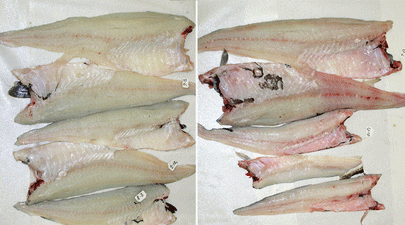
Facts
The following bleeding and gutting methods were used:
Bleeding:
- Single cut method: Cutting the artery from the heart to the gills, but not the two arteries from the gills
- Double cut method: Cutting both the arteries from the gills, but not the artery from the heart to the gills
- Throat cut (trawler bleeding): Cutting through the throat, right down on both sides
- Gill cut: Cutting off all the gill latches on one side
Gutting:
- Direct gutting with head on: Gutting of unbled fish without heading
- Direct gutting with head off: Gutting of unbled fish and heading in one operation
- Unbled and ungutted (control fish): Round fish were kept unbled in ice for approx. 20 hours before being gutted and cleaned.
Sensory Assessment
A sensory assessment, in which trained sensory assessors assess whole fish and loins, shows that the largest difference occurs between immediate bleeding and when the fish is bled 30 minutes after capture. The analysis that was performed showed a pronounced decline in the draining of blood when time elapsed before the fish was bled.
Technical Analysis Supports Sensory Result
In addition to the sensory assessment, a technical analysis of the fish was performed to confirm what could be seen with the naked eye. The analysis does not provide an exact measurement of the blood quantity, but is ideally suited for ranking various samples according to blood content.
For loins the blood index increased constantly depending on how long it took for the fish, and as such confirmed the assessment of the sensory assessors. Naturally enough, the index for this method peaked for raw material that had not been bled, says Senior Scientist Leif Akse.
The result clearly shows concurrence between the sensory assessment and the instrumental analysis.
Direct Gutting gives Poor Blood Draining
Direct gutting soon after capture results in poorer bleeding than if the fish is bled in water prior to gutting. This results in blood spots in the loins and belly of the fish. This was established in experiments carried out recently by Nofima scientists.
The blood index measurements showed no significant difference between different bleeding methods. This is in accordance with other reports based on bleeding of farmed salmon. However, the blood index was significantly lower for all methods in the project than equivalent measurements of fish that were directly gutted and headed immediately after capture.
With a delay of 30 minutes before bleeding starts, direct gutting of headed fish also results in more blood spots in the loins than if the fish was bled. With longer time intervals before bleeding starts (1 and 3 hours), there was no significant difference in the blood index between the bleeding methods and direct gutting.
December 2012




